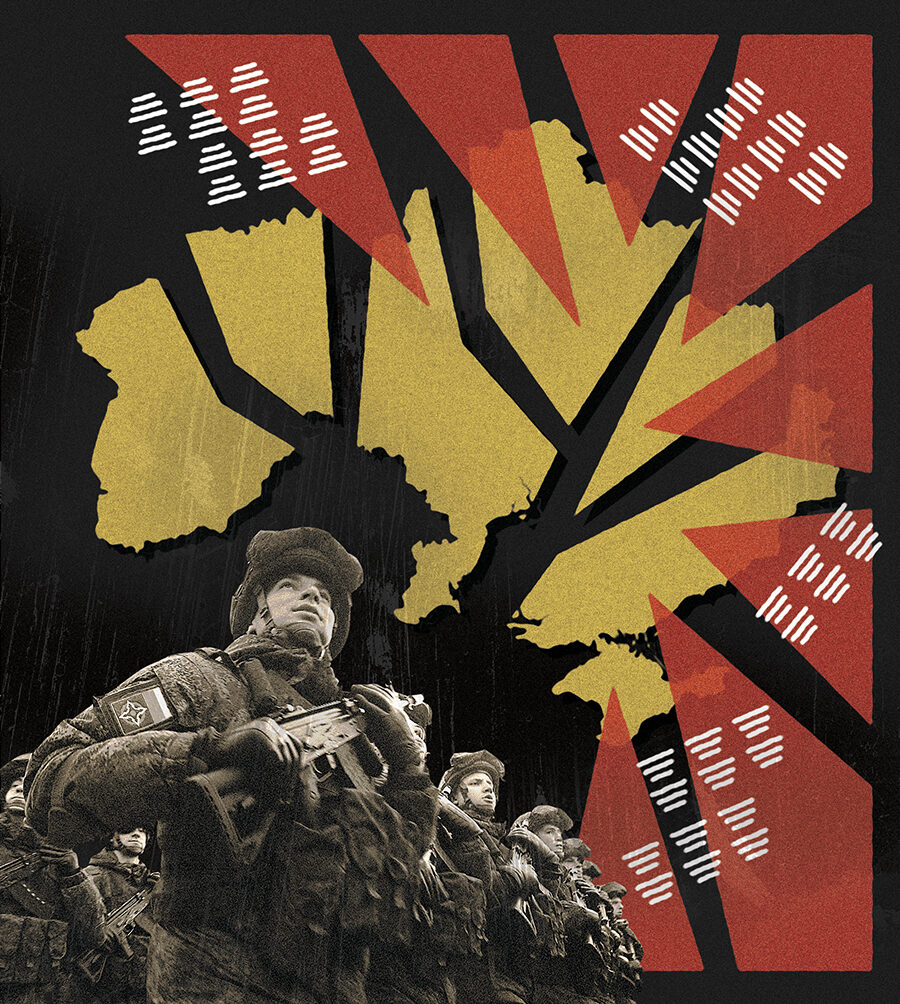
Collage by Stephanie Cuenca. Source images: Russian servicemen © Pavel Mikheyev/Reuters/Alamy; map of Ukraine © Aleksandar Ilic/Alamy
The Russian invasion of Ukraine on February 24 was a dark day for Europe, but a rare public triumph for American and British spies. After nearly two decades in the doghouse for misleading and often false claims about Iraqi weapons of mass destruction, this time, despite the naysayers, they appear to have gotten it right: going to war was Putin’s plan all along. In a stunning new gambit, our leaders spent the months leading up to the invasion broadcasting their intelligence to the world, telling everyone what they knew about what Putin was going to do. Then he did it.
This all began in early December, with a series of authorized leaks and anonymous briefings made by senior Biden Administration officials to the Washington Post. The Post published satellite photos from an unclassified intelligence document showing Russian forces being moved toward the Ukrainian border and into Crimea. Investigative reporters can spend years using freedom of information requests to pry ancient military documents from government archives, but this piece of intelligence was handed to journalists on a platter. American officials judged the number of Russian soldiers near Ukraine to be 70,000, the report said, but they predicted a buildup to 175,000, and described troop movements designed “to obfuscate intentions and to create uncertainty.” The plan, officials told the Post, might have been “to force Ukrainian troops to fight on multiple fronts, seeking not so much territory but rather a capitulation by Kyiv and its Western backers.” By mid-February, Biden was ordering Americans to leave Ukraine within forty-eight hours. The invasion, he warned, could begin at any time.
Such a tactic wasn’t popular among spies, who dislike their sources and methods being compromised. Telling everyone what you know is a novel strategy in the world of espionage, where guarding state secrets and deploying them judiciously is the essence of the craft. “U.S. intelligence capabilities are dear,” the former CIA officer Douglas London wrote in Foreign Affairs on February 15. “The insights they provide are hardly limitless, and one can only go to the well so often before it runs dry or one’s adversaries adapt.”
And these disclosures did not please those on the receiving end of Russian intimidation. In statement after exasperated statement, the Ukrainian president Volodymyr Zelensky warned that Western officials were essentially doing Putin’s work for him—by releasing a glut of intelligence, they were driving away foreign investors, inciting panic, and further inflaming a delicate situation. Rhetoric about an imminent invasion makes it “as acute and burning as possible,’’ Zelensky complained at the end of January, noting that he thought the American approach was a “mistake.” “We can’t say the war will happen tomorrow or by the end of February,” he told reporters. “Yes, it may happen, unfortunately. But you have to feel the pulse on a day-to-day basis.” In a call with Biden at around the same time, according to CNN, Zelensky urged the administration to “calm down the messaging,” expressing hope that diplomatic efforts would yet bear fruit.
In retrospect, Zelensky’s attitude might seem naïve. But if detailed American and British intelligence was being shared among NATO partners to help maintain unity, not all of it was making its way to the Ukrainian government, which had no idea how the Americans could know what they claimed to know. The initial leak to the Post had been timed not to offer specific help to the Ukrainians, but to land just four days before Biden and Putin had a secure call. “Biden wanted that information out in the world before he spoke with Putin. And he wanted Putin to know that we knew and we were going to make sure the world knew,” a senior administration official told the paper in the wake of the invasion. “It was the start of a new phase where we were talking about what we were seeing. This is a very different way to do diplomacy.”
The exuberance of the reporters who received this juicy intelligence occasionally bordered on hubris, which was all the more jarring when it became clear that this allegedly ingenious new approach to diplomacy had failed to avert a war. “We learned collectively from Russia’s disinformation campaigns in the past,” one American diplomat turned wonk enthused in the Post. “This time, the United States was very, very proactive in calling out Vladimir Putin before he could act, and the United States was pretty accurate about its forecasts.” The New York Times’ David E. Sanger, originally skeptical of the ploy, wrote at the start of the invasion, in a piece co-authored by Julian E. Barnes, that “the success of American intelligence in reading Mr. Putin and stripping away any element of surprise” was “one of the most striking developments of the crisis.” If this was success, a skeptic might wonder what would count as failure. Waving intelligence around in public was never likely to intimidate Putin or interfere with his game plan. In fact, it might well have made matters considerably worse.
Let’s call it Operation Overshare: the strategic lobbing of intelligence into the public domain to advance diplomatic objectives. Declassifying intelligence for immediate political gain is not unheard of. During the 1962 Cuban Missile Crisis, the American ambassador Adlai Stevenson revealed photos at the United Nations proving that the Soviets were lying when they denied the presence of missiles on the island. More than forty years later, then–secretary of state Colin Powell’s fateful speech at the United Nations Security Council was intended to do something similar—to foster broad international support for an invasion of Iraq by exaggerating what U.S. intelligence agencies knew about the extent of Saddam Hussein’s arsenal of chemical and biological, and maybe even nuclear, weapons of mass destruction. The affair poisoned the relationship between intelligence agents and diplomats for years to come.
This new sort of disclosure, however, was more about flaunting the intelligence at our disposal. Operation Overshare has its roots in 21st Century Statecraft, an Obama-era initiative to rethink diplomacy for the internet age. Pioneered by then–secretary of state Hillary Clinton and some bright young things from her policy planning staff, the idea was to complement the stuffy tools of old-fashioned diplomacy with fresh new ways of engaging people around the world, to leverage American expertise in tech and social media in order to win friends and spark change from the bottom up, particularly when it came to authoritarian regimes. During the Iranian election protests in June 2009, for example, the Obama Administration urged Twitter to delay a routine shutdown so that activists could continue to share information.
The 21st Century Statecraft initiative attracted substantial interest in the years leading up to the Arab Spring, when it was briefly imagined that Facebook and Twitter could usher in freedom and democracy. This idea fell flat on its face when it came up against the brute force of the Syrian and Russian militaries. By the time the world watched the Islamic State behead Americans on YouTube, optimism about the internet fostering a new brotherhood of man had withered.
Even so, Operation Overshare relied on this same belief in the power of ubiquitous internet connectivity. In addition to spycraft and communication intercepts, the intelligence regarding Russia’s plans was gleaned from a panoply of public, “open-source” material—satellite imagery, livestreams, and clips uploaded to Facebook, Telegram, and Twitter. This new enthusiasm for intelligence transparency was at least in part the U.S. government’s way of adapting to the chatty openness and information-wants-to-be-free culture of the internet.
It was also a way of making amends for a perceived lack of candor in the recent past. Last summer, the United States was caught on the hop by the Taliban’s rout of the Afghan army, and was subsequently castigated for not coordinating with its allies to organize a swift evacuation of American citizens. Officials hadn’t been forthright enough about the limitations of their intelligence, went the criticism. This time Biden was determined to do better.
Different justifications were offered at various stages of Russia’s troop buildup. Before the invasion, much of the conversation was centered on how the disclosures might deter Putin from attacking in the first place, and how transparency might restore trust in American bona fides. The strategy was pushed primarily by Jake Sullivan, Biden’s national security adviser, who worked in the State Department during the Obama Administration. In addition to trying to throw Putin off-balance with the news that U.S. spies were onto him, the broader strategy was to pile international pressure on the Russians to back down, and to “control the narrative” so that if an invasion occurred, Putin would at least be revealed as a liar.
Admittedly, the prognostications of that first blockbuster intelligence leak to the Post look eerily accurate in hindsight. But they were followed by some shakier revelations—one about a Russian scheme for a “false flag” attack on its own forces, which, despite much searching, never really materialized. More revelations came in late January, this time from British officials likely encouraged by their American counterparts, concerning an alleged Russian plot to establish a puppet government with five named Ukrainian politicians.
By mid-February, Sullivan was imploring Americans to get out of Ukraine, and signaling that there would be crippling sanctions should Russia move forward with the invasion. “The president believes that sanctions are intended to deter,” he told reporters. Less than two weeks later, as Russian armor rolled from Belgorod into Ukraine, Biden was forced to issue another clarification: “No one expected the sanctions to prevent anything from happening.”
Many analysts now share the government’s judgment that Putin was planning to invade all along. But it seems more likely that he was keeping his options open, massing brute military force on the border with Ukraine to press for diplomatic concessions and a new security pact. The barrage of intelligence disclosures was, in all likelihood, an annoyance to Putin, who spent the early years of his career as a Soviet intelligence officer. But whatever was going on in Putin’s head, Ukraine’s leaders badly needed talking to work. Conflict diplomacy has traditionally been a poker game played quietly and with bluff confidence, and that’s clearly what Putin wanted. To a Cold War apparatchik like him, invading was simply another form of diplomacy, a method of brinksmanship in which he could use his military advantage to force the Ukrainians and NATO back to the table.
This time, however, our leaders were playing a different game. After being humbled in Iraq and Afghanistan, it was clear that the United States wasn’t going to put troops in Ukraine and risk a world war. Instead, the United States would make its responses to a Russian invasion clear ahead of time, which included sanctions, an admission that there was going to be no military intervention, and a warning that Americans should head home immediately. Then it left the Ukrainians to their fate.
But Putin didn’t much care that the United States was revealing his alleged plans to the world. Knowing what’s going on and telling everyone, it turns out, doesn’t really matter if there’s nothing you can do about it. One likely reason that American and British intelligence agencies launched Operation Overshare is that their state-of-the-art sources and spy tools make little difference without military involvement. In his Foreign Affairs essay, London, the former CIA officer, weighed the dilemma. “There is risk in any exercise of power,” he wrote, “but for that matter, there is also risk in not acting at all.” Offering up some intelligence was a reasonable deterrence strategy, but required a careful balancing act: “The Biden administration needs to take care that its big revelations not only have a big impact but also don’t tie its own hands.”
In the end, the revelations didn’t stop Putin, and they did unnecessarily tie American hands. In their haste to control the story, the officials behind Operation Overshare mimicked the style of Putin’s own propaganda efforts, throwing out so much chatter and so many scenarios that they did little more than needlessly raise the stakes, giving rise to a paralyzing flood of lurid possibilities, distracting from diplomatic attempts to give Putin a face-saving way out, and quite possibly forcing events to an explosive denouement.
The revelations of Operation Overshare have only just begun. Thus far our national security journalists have gotten some great stories, even if their breathless copy sometimes reads as fan fiction. Our spymasters have helped restore some of their credibility amid widespread public mistrust. And our politicians, much like Putin, have found a way to distract us from their policy failures back home.
In the absence of a diplomatic solution, Ukrainians are left to fight for themselves, with only their phones and social media to record their fate. This might help with the whole transparency show, and will delight ambulance chasers in the international media and human rights industry, but it won’t be enough to keep them safe. Just like oversharing on the internet, Ukrainians might conclude, Western non-diplomacy sprang from deep-seated narcissism and a need for validation, a compensation for feelings of inadequacy. Its only perceptible effect may have been to wind everyone up.





